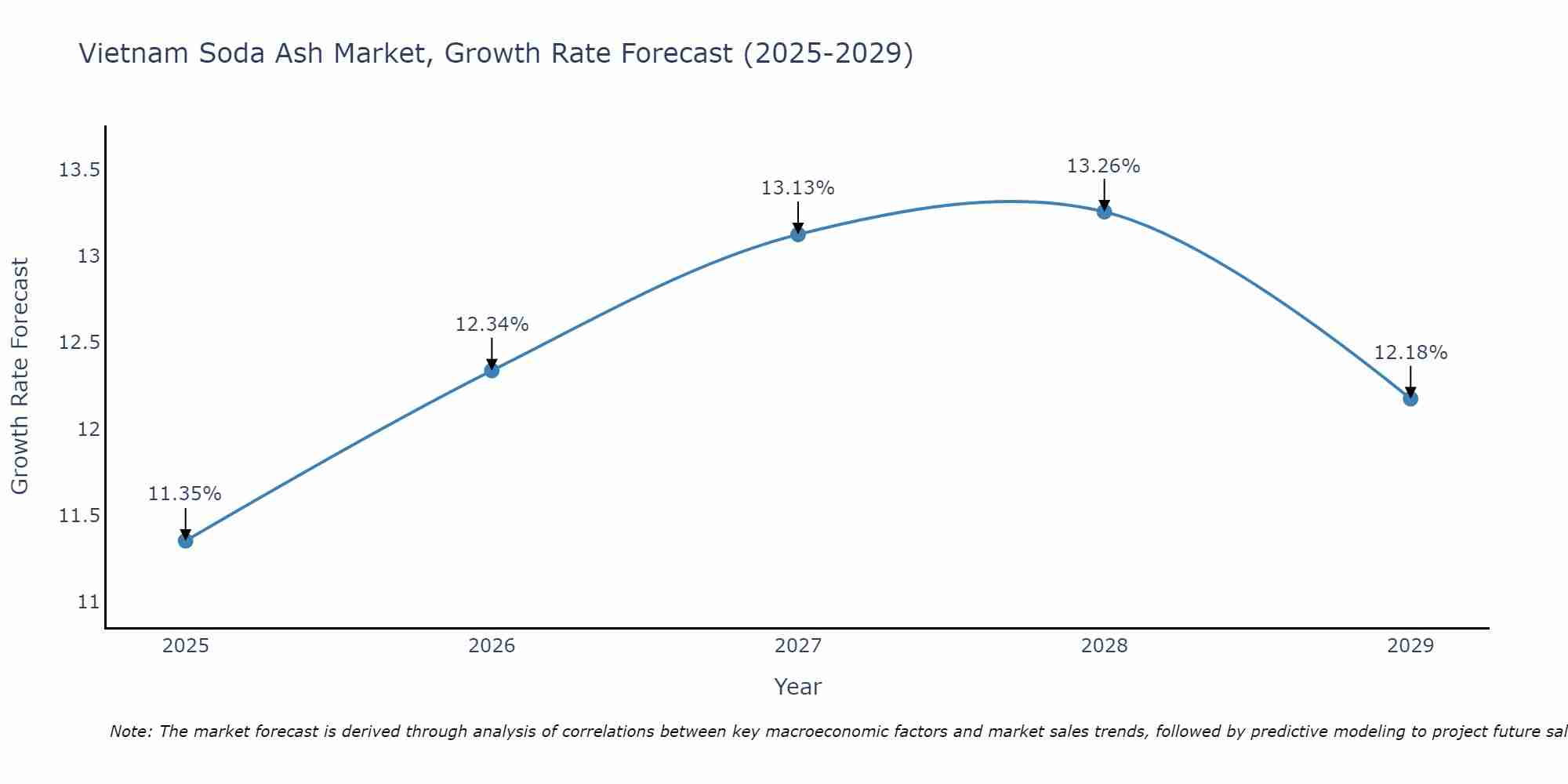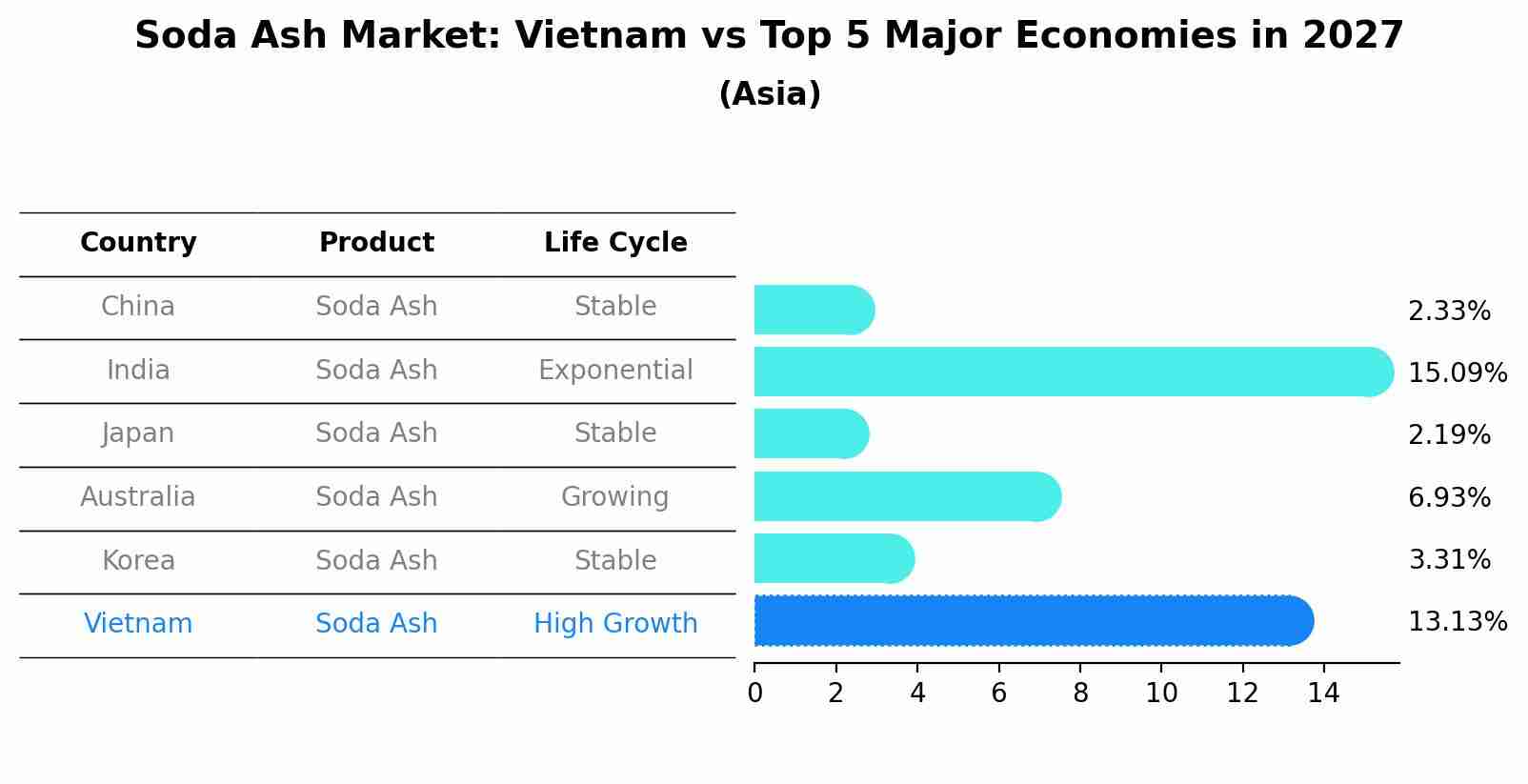Vietnam Soda Ash Market (2025-2031) Outlook | Share, Forecast, Size, Analysis, Trends, Growth, Value, Industry, Companies, Revenue
| Product Code: ETC347310 | Publication Date: Aug 2022 | Updated Date: Aug 2025 | Product Type: Market Research Report | |
| Publisher: 6Wresearch | No. of Pages: 75 | No. of Figures: 35 | No. of Tables: 20 | |
Vietnam Soda Ash Market Size Growth Rate
The Vietnam Soda Ash Market is projected to witness mixed growth rate patterns during 2025 to 2029. Starting at 11.35% in 2025, the market peaks at 13.26% in 2028, and settles at 12.18% by 2029.

Soda Ash Market: Vietnam vs Top 5 Major Economies in 2027 (Asia)
By 2027, Vietnam's Soda Ash market is forecasted to achieve a high growth rate of 13.13%, with China leading the Asia region, followed by India, Japan, Australia and South Korea.

Vietnam Soda Ash Market Synopsis
The Vietnam soda ash market plays a crucial role in several industries, particularly glass manufacturing, detergents, and chemicals. Soda ash, also known as sodium carbonate, is a key raw material in these sectors. As industrialization and urbanization continue in Vietnam, the demand for glass products, detergents, and chemicals has been steadily growing. This has resulted in an increased need for soda ash as a primary ingredient. The market is influenced by global supply and demand dynamics and is sensitive to pricing fluctuations.
Drivers of the Market
The soda ash market in Vietnam is experiencing robust growth, driven by various factors. One of the key drivers is the booming construction and real estate sectors in the country. Soda ash is a critical ingredient in the production of glass, which is extensively used in construction. As Vietnam infrastructure development continues, the demand for soda ash remains high. Furthermore, the textile and chemical industries also rely heavily on soda ash as a raw material, and these sectors are expanding rapidly, bolstering the market further. Additionally, Vietnam strategic location for exports makes it a competitive player in the global soda ash market.
Challenges of the Market
Challenges in the Vietnam soda ash market include environmental regulations that require the adoption of cleaner production methods, which may increase costs. Fluctuating global prices of raw materials like trona and limestone can impact the competitiveness of domestic producers. Moreover, competition from imported soda ash products can pose challenges for local manufacturers. Energy costs, especially for energy-intensive production processes, are also a concern in maintaining profitability.
COVID-19 Impact on the Market
The Vietnam soda ash market faced challenges during the pandemic, primarily due to disruptions in manufacturing and export activities. Decreased industrial production and international trade restrictions affected the market`s performance. Recovery depended on the revival of industrial sectors and global trade.
Key Players in the Market
The Vietnam Soda Ash market features key players like Solvay Chemicals and Tata Chemicals. Solvay Chemicals, a global leader, supplies high-quality soda ash products to various industries, including glass, detergents, and chemicals. Tata Chemicals, with its production facility in Vietnam, is a significant contributor to the market`s growth, catering to the increasing demand for soda ash in the region. Their commitment to sustainability and product quality has earned them a prominent position in the market.
Key Highlights of the Report:
- Vietnam Soda Ash Market Outlook
- Market Size of Vietnam Soda Ash Market, 2024
- Forecast of Vietnam Soda Ash Market, 2031
- Historical Data and Forecast of Vietnam Soda Ash Revenues & Volume for the Period 2021-2031
- Vietnam Soda Ash Market Trend Evolution
- Vietnam Soda Ash Market Drivers and Challenges
- Vietnam Soda Ash Price Trends
- Vietnam Soda Ash Porter's Five Forces
- Vietnam Soda Ash Industry Life Cycle
- Historical Data and Forecast of Vietnam Soda Ash Market Revenues & Volume By Type for the Period 2021-2031
- Historical Data and Forecast of Vietnam Soda Ash Market Revenues & Volume By Natural for the Period 2021-2031
- Historical Data and Forecast of Vietnam Soda Ash Market Revenues & Volume By Synthetic for the Period 2021-2031
- Historical Data and Forecast of Vietnam Soda Ash Market Revenues & Volume By Application for the Period 2021-2031
- Historical Data and Forecast of Vietnam Soda Ash Market Revenues & Volume By Glass for the Period 2021-2031
- Historical Data and Forecast of Vietnam Soda Ash Market Revenues & Volume By Soap & Detergents for the Period 2021-2031
- Historical Data and Forecast of Vietnam Soda Ash Market Revenues & Volume By Chemicals for the Period 2021-2031
- Historical Data and Forecast of Vietnam Soda Ash Market Revenues & Volume By Pulp & Paper for the Period 2021-2031
- Historical Data and Forecast of Vietnam Soda Ash Market Revenues & Volume By Metal Processing for the Period 2021-2031
- Historical Data and Forecast of Vietnam Soda Ash Market Revenues & Volume By Water Treatment for the Period 2021-2031
- Vietnam Soda Ash Import Export Trade Statistics
- Market Opportunity Assessment By Type
- Market Opportunity Assessment By Application
- Vietnam Soda Ash Top Companies Market Share
- Vietnam Soda Ash Competitive Benchmarking By Technical and Operational Parameters
- Vietnam Soda Ash Company Profiles
- Vietnam Soda Ash Key Strategic Recommendations
Frequently Asked Questions About the Market Study (FAQs):
1 Executive Summary |
2 Introduction |
2.1 Key Highlights of the Report |
2.2 Report Description |
2.3 Market Scope & Segmentation |
2.4 Research Methodology |
2.5 Assumptions |
3 Vietnam Soda Ash Market Overview |
3.1 Vietnam Country Macro Economic Indicators |
3.2 Vietnam Soda Ash Market Revenues & Volume, 2021 & 2031F |
3.3 Vietnam Soda Ash Market - Industry Life Cycle |
3.4 Vietnam Soda Ash Market - Porter's Five Forces |
3.5 Vietnam Soda Ash Market Revenues & Volume Share, By Type, 2021 & 2031F |
3.6 Vietnam Soda Ash Market Revenues & Volume Share, By Application, 2021 & 2031F |
4 Vietnam Soda Ash Market Dynamics |
4.1 Impact Analysis |
4.2 Market Drivers |
4.2.1 Growth in the glass industry, as soda ash is a key component in glass manufacturing. |
4.2.2 Increasing demand from the detergent and chemical industries for applications like water treatment and soap production. |
4.2.3 Expansion of the construction sector, leading to higher demand for soda ash in the production of building materials. |
4.3 Market Restraints |
4.3.1 Fluctuating prices of raw materials like salt and limestone, which are key ingredients in soda ash production. |
4.3.2 Environmental regulations impacting the mining and processing of soda ash. |
4.3.3 Competition from alternative products or substitutes in end-user industries. |
5 Vietnam Soda Ash Market Trends |
6 Vietnam Soda Ash Market, By Types |
6.1 Vietnam Soda Ash Market, By Type |
6.1.1 Overview and Analysis |
6.1.2 Vietnam Soda Ash Market Revenues & Volume, By Type, 2021-2031F |
6.1.3 Vietnam Soda Ash Market Revenues & Volume, By Natural, 2021-2031F |
6.1.4 Vietnam Soda Ash Market Revenues & Volume, By Synthetic, 2021-2031F |
6.2 Vietnam Soda Ash Market, By Application |
6.2.1 Overview and Analysis |
6.2.2 Vietnam Soda Ash Market Revenues & Volume, By Glass, 2021-2031F |
6.2.3 Vietnam Soda Ash Market Revenues & Volume, By Soap & Detergents, 2021-2031F |
6.2.4 Vietnam Soda Ash Market Revenues & Volume, By Chemicals, 2021-2031F |
6.2.5 Vietnam Soda Ash Market Revenues & Volume, By Pulp & Paper, 2021-2031F |
6.2.6 Vietnam Soda Ash Market Revenues & Volume, By Metal Processing, 2021-2031F |
6.2.7 Vietnam Soda Ash Market Revenues & Volume, By Water Treatment, 2021-2031F |
7 Vietnam Soda Ash Market Import-Export Trade Statistics |
7.1 Vietnam Soda Ash Market Export to Major Countries |
7.2 Vietnam Soda Ash Market Imports from Major Countries |
8 Vietnam Soda Ash Market Key Performance Indicators |
8.1 Energy efficiency in soda ash production processes. |
8.2 Percentage of soda ash produced meeting quality standards. |
8.3 Adoption rate of innovative technologies in soda ash manufacturing processes. |
9 Vietnam Soda Ash Market - Opportunity Assessment |
9.1 Vietnam Soda Ash Market Opportunity Assessment, By Type, 2021 & 2031F |
9.2 Vietnam Soda Ash Market Opportunity Assessment, By Application, 2021 & 2031F |
10 Vietnam Soda Ash Market - Competitive Landscape |
10.1 Vietnam Soda Ash Market Revenue Share, By Companies, 2024 |
10.2 Vietnam Soda Ash Market Competitive Benchmarking, By Operating and Technical Parameters |
11 Company Profiles |
12 Recommendations |
13 Disclaimer |
- Single User License$ 1,995
- Department License$ 2,400
- Site License$ 3,120
- Global License$ 3,795
Search
Related Reports
- Saudi Arabia Manlift Market (2025-2031) | Outlook, Size, Growth, Trends, Companies, Industry, Revenue, Value, Share, Forecast & Analysis
- Uganda Excavator, Crane, and Wheel Loaders Market (2025-2029) | Strategy, Consumer Insights, Analysis, Investment Trends, Opportunities, Growth, Size, Share, Industry, Revenue, Segments, Value, Segmentation, Supply, Forecast, Restraints, Outlook, Competition, Drivers, Trends, Demand, Pricing Analysis, Competitive, Strategic Insights, Companies, Challenges
- Rwanda Excavator, Crane, and Wheel Loaders Market (2025-2031) | Strategy, Consumer Insights, Analysis, Investment Trends, Opportunities, Growth, Size, Share, Industry, Revenue, Segments, Value, Segmentation, Supply, Forecast, Restraints, Outlook, Competition, Drivers, Trends, Demand, Pricing Analysis, Competitive, Strategic Insights, Companies, Challenges
- Kenya Excavator, Crane, and Wheel Loaders Market (2025-2031) | Strategy, Consumer Insights, Analysis, Investment Trends, Opportunities, Growth, Size, Share, Industry, Revenue, Segments, Value, Segmentation, Supply, Forecast, Restraints, Outlook, Competition, Drivers, Trends, Demand, Pricing Analysis, Competitive, Strategic Insights, Companies, Challenges
- Angola Excavator, Crane, and Wheel Loaders Market (2025-2031) | Strategy, Consumer Insights, Analysis, Investment Trends, Opportunities, Growth, Size, Share, Industry, Revenue, Segments, Value, Segmentation, Supply, Forecast, Restraints, Outlook, Competition, Drivers, Trends, Demand, Pricing Analysis, Competitive, Strategic Insights, Companies, Challenges
- Israel Intelligent Transport System Market (2025-2031) | Strategy, Consumer Insights, Analysis, Investment Trends, Opportunities, Growth, Size, Share, Industry, Revenue, Segments, Value, Segmentation, Supply, Forecast, Restraints, Outlook, Competition, Drivers, Trends, Demand, Pricing Analysis, Competitive, Strategic Insights, Companies, Challenges
- Uganda Precast and Aggregate Market (2025-2031) | Strategy, Consumer Insights, Analysis, Investment Trends, Opportunities, Growth, Size, Share, Industry, Revenue, Segments, Value, Segmentation, Supply, Forecast, Restraints, Outlook, Competition, Drivers, Trends, Demand, Pricing Analysis, Competitive, Strategic Insights, Companies, Challenges
- Australia IT Asset Disposal Market (2025-2031) | Strategy, Consumer Insights, Analysis, Investment Trends, Opportunities, Growth, Size, Share, Industry, Revenue, Segments, Value, Segmentation, Supply, Forecast, Restraints, Outlook, Competition, Drivers, Trends, Demand, Pricing Analysis, Competitive, Strategic Insights, Companies, Challenges
- UAE Building Thermal Insulation Market Outlook (2025-2031) | Revenue, Companies, Share, Trends, Growth, Size, Forecast, Industry, Analysis & Value
- Portugal Electronic Document Management Market (2025-2031) | Strategy, Consumer Insights, Analysis, Investment Trends, Opportunities, Growth, Size, Share, Industry, Revenue, Segments, Value, Segmentation, Supply, Forecast, Restraints, Outlook, Competition, Drivers, Trends, Demand, Pricing Analysis, Competitive, Strategic Insights, Companies, Challenges
Industry Events and Analyst Meet
Our Clients
Whitepaper
- Middle East & Africa Commercial Security Market Click here to view more.
- Middle East & Africa Fire Safety Systems & Equipment Market Click here to view more.
- GCC Drone Market Click here to view more.
- Middle East Lighting Fixture Market Click here to view more.
- GCC Physical & Perimeter Security Market Click here to view more.
6WResearch In News
- Doha a strategic location for EV manufacturing hub: IPA Qatar
- Demand for luxury TVs surging in the GCC, says Samsung
- Empowering Growth: The Thriving Journey of Bangladesh’s Cable Industry
- Demand for luxury TVs surging in the GCC, says Samsung
- Video call with a traditional healer? Once unthinkable, it’s now common in South Africa
- Intelligent Buildings To Smooth GCC’s Path To Net Zero













